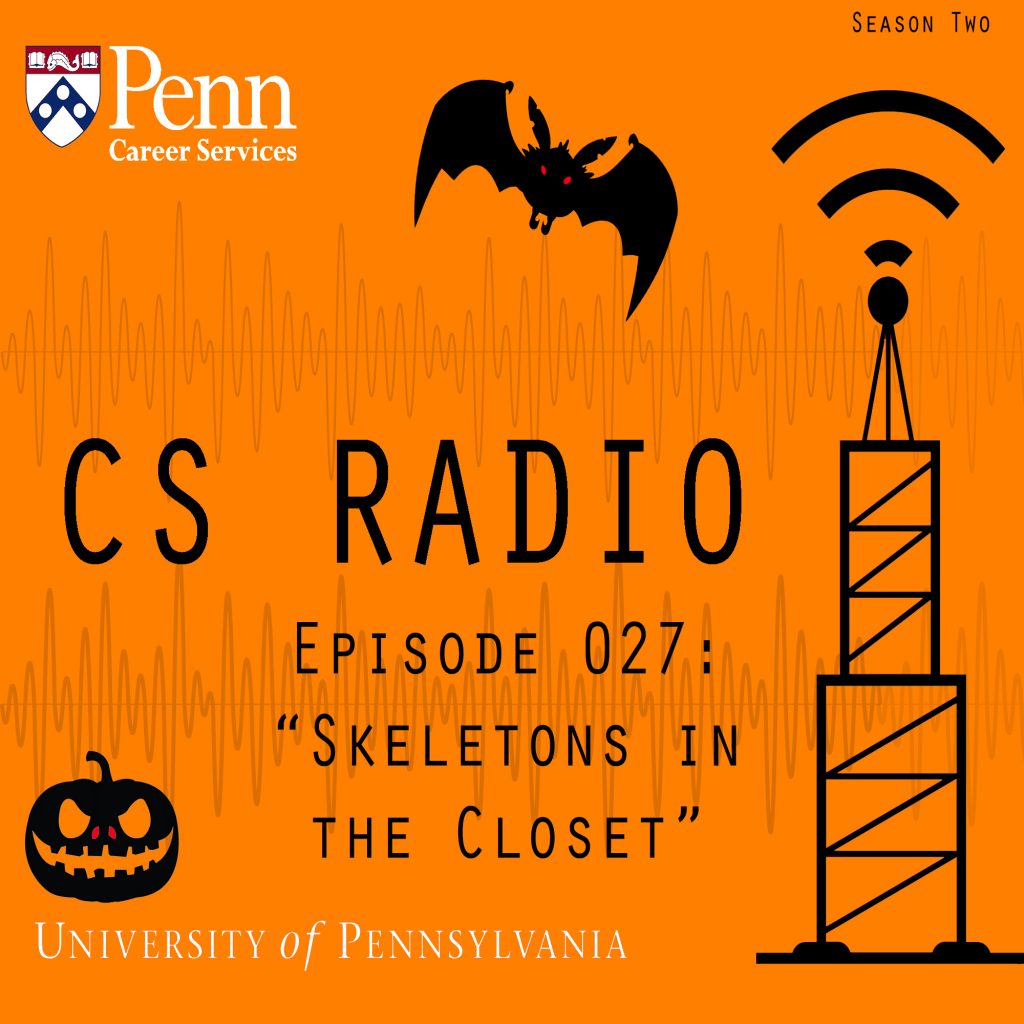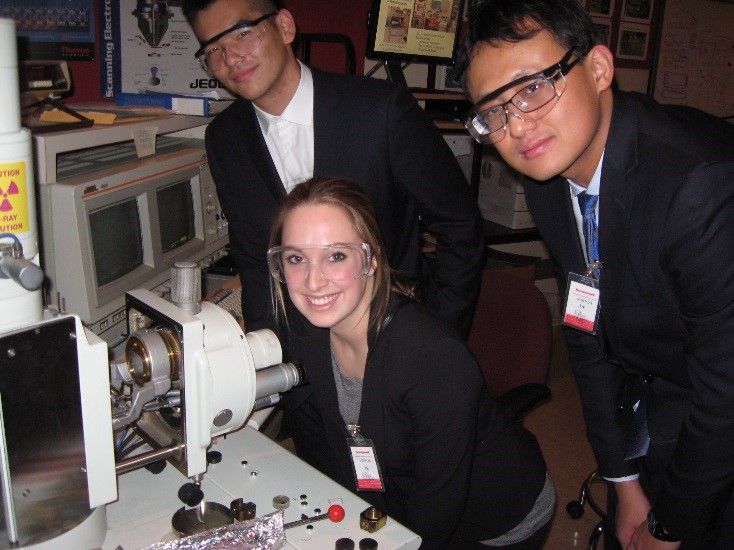Happy Halloween! It’s time to tell spooky tales – and this year we’re digging up all the skeletons in our closet! Michael and Mylène welcome Senior Associate Director Claire Klieger to the studio to discuss how to deal with difficult moments from your past in a job search. Whether there’s a rough semester on your transcript, you took time off, you don’t exactly match the job description or something (seemingly) more serious, we’re going to help you exercise those demons! All that, plus the usual rundown of this week’s events. Enjoy!
Month: October 2016
On the Brink
This the next in a series of posts by recipients of the Career Services Summer Funding Grant. We’ve asked funding recipients to reflect on their summer experiences and talk about the industries in which they’ve been spending their summer. You can read the entire series here.
This entry is by Jennifer Wright, COL ’17
 Eighth graders are on the brink. They are not yet in high school, but are showing signs of the transition from their middle school selves. With a good dose of enthusiasm for learning still in them, they can be tasked with more responsibility and be held to higher expectations than their younger middle school peers.
Eighth graders are on the brink. They are not yet in high school, but are showing signs of the transition from their middle school selves. With a good dose of enthusiasm for learning still in them, they can be tasked with more responsibility and be held to higher expectations than their younger middle school peers.
I discovered this by teaching Social Studies to a group of dynamic 8th graders over six weeks this past summer. I have never been so challenged, yet so rewarded by any single experience as I was teaching at Breakthrough Greater Boston.
Breakthrough puts high-potential, low-income middle school students on the path towards college by following 6th graders through high school. In the summertime, it serves a dual purpose as an academic enrichment program and a pre-service teacher training program for 1,000 undergrads in cities across the country.
Having lived my entire life in Philadelphia, Boston was the chance for adventure and the opportunity to test the waters of being an educator. Before Breakthrough I wondered whether I was really up for the task of educating, especially in an urban school – the type of environment that I feel connected to based on my own public school experience in Philly. However, I wrote the following in my teaching journal for July 26th: “If I thought I couldn’t do this job before, I know now that I can… with the proper supports and continued training, of course.”
As a Social Studies teacher, I proposed a class centered around the upcoming presidential election. I challenged my students to mingle their own curiosities and prior knowledge with critical material to make them more informed citizens and future voters. We studied primary and secondary sources, “registered” to vote, created original ballot propositions and wrote campaign speeches.
I dove head-first into implementing my own original lesson plans to students of highly varied academic levels with varying success. Drawing on the support of an experienced instructional coach who observed my teaching several times a week, I refined my “teacher moves”. I worked to encourage positive class behaviors. I practiced decreasing the amount I spoke and increasing the opportunities for my students’ voices to be heard in class. The satisfaction came from higher quality classes and more engaged students with every revised lesson plan. The better I got at guiding them, the more insightful and productive the students became in their own right.
It was surprising, but gratifying how quickly my fellow teachers and I built relationships with our students as we learned side-by-side in class. It illuminated the real reason I’ve always felt drawn to education: the relationships.
I have heard teaching be compared to tending a seed that you won’t often get the chance to see bloom until much later. The truth is that my students and I were all seeds this summer. If gardening is really anything like teaching – it’s an exercise in patience, care and ultimately, in the trust that you’ll see the product of the hard work tomorrow – making them more prepared for 8th grade in the fall and me for a lifetime of tending seeds.
The Value of Job Shadowing
Tiffany Franklin, Associate Director
The leaves are turning colors, crisp autumn nights are becoming the norm and you can find pumpkin versions of most of your favorite foods. Fall is officially upon us and that means it’s the perfect time to consider an externship as part of your internship/job search strategy. Externships are job shadowing opportunities designed to help students discern how their skills and interests align with professional positions in their career fields of interest.
By participating in a “day in a life” within a work environment, you can gain exposure to an industry, insightful conversation, invaluable advice, and an insider perspective.
Externships are typically job shadowing opportunities that are a half or full-day in duration and may involve the following activities:
- Conducting informational interviews with professionals in a range of departments and levels
- Participating in daily operations that provide hands-on exposure to the career field/industry
- Completing a relevant project if the externship is long enough to accommodate it
- Attending meetings and presentations
- Touring the work site
Depending on your school and year, you can participate in one of the structured job shadowing programs through Career Services (for example, the Engineering Externship Program or Discovery Days) or you can create this type of opportunity on your own through networking, which is simply connecting with people. Perhaps you have a friend with a relative working in a field that interests you. You could see if that person could introduce you and begin by scheduling a brief informational interview. Once you’ve established a rapport over time, you could inquire whether any job shadowing opportunities are available. Career Services advisors are here to help you consider both the timing and content of this type of outreach.
The Engineering Externship Program connects returning students with alumni and their colleagues at their workplaces in January, just before spring semester classes begin. The program is open to SEAS sophomores, juniors, and first year master’s students with first priority going to sophomores and then juniors. Externship sites include different types of companies, in locations across the U.S. and overseas. Consult your upcoming weekly newsletters from Career Services for full application details.
Discovery Days is a program which allows College of Arts and Sciences and Wharton sophomores a chance to observe a “day in the life” of professionals in careers of interest to them. Consult your upcoming weekly newsletters from Career Services for full application details. This program takes place in January 2017 prior to spring classes.
Whether it’s through a formal program through Career Services or through your own networking, job shadowing is an excellent way to supplement your research about a career field. By meeting with professionals who do what you hope to, you will have the opportunity to ask questions, gain insights into the challenges they face, and learn from their experience.
Penn x3
This the next in a series of posts by recipients of the Career Services Summer Funding Grant. We’ve asked funding recipients to reflect on their summer experiences and talk about the industries in which they’ve been spending their summer. You can read the entire series here.
This entry is by Elena Schivone, COL ’18
 This summer was a busy one: I was working at three Penn research centers. Despite running back and forth across campus for my shifts, I truly enjoyed being able to be a part of the various research projects I worked on.
This summer was a busy one: I was working at three Penn research centers. Despite running back and forth across campus for my shifts, I truly enjoyed being able to be a part of the various research projects I worked on.
Center for Mental Health Policy and Services Research (CMHPSR)
At CMHPSR, I worked on a project which is responsible for implementing trauma-focused evidence-based practices and for increasing screening of youth mental health. Performing administrative tasks enabled me to become very familiar with the research project’s outcome measures and see firsthand how the project aided youth in Philadelphia. In addition, I was able to become familiar with various software programs commonly used in data analysis and paper writing. I also took part in the center’s journal club, which meets monthly to discuss recently published implementation science papers. I found it very valuable to discuss research with faculty and doctoral students. It was very interesting to note what aspects of the research they found substantial, to discuss the project’s methodology, and the challenges which this sub-field of implementation science research faces. I greatly enjoyed being able to brainstorm possible solutions to such challenges.
Boundaries of Anxiety and Depression Laboratory
This summer I was able to continue my work at this lab, which hopes to advance understanding of anxiety and depression by investigating their relationship to one another and to normal emotional experiences. I ran participants in the labs various studies, processed data, and performed some administrative tasks. I also helped edit a paper written by the lab’s principal investigator, Dr. Ruscio, to prepare it for submission. The lab’s studies have created a large database that I have been granted access to. I am currently using their database to prepare a poster for submission to a psychology conference. My time at Dr. Ruscio’s lab not only helped me develop data collection and analysis skills, but I also gain insight and receive advice concerning psychology graduate school and careers. During some lab meetings discussed psychology graduate school programs and their application process from those who have experienced it firsthand as applicants and as acceptance committee members.
Cognition and Development Lab (Cog Dev)
Working at Cog Dev was my first experience in non-clinical related psychology research. While I am very interested in clinical psychology, I am glad that I was able to experience another area. A t Cog Dev I worked on two projects. The first analyzes the efficacy of different types of stories at teaching children. The second studies the causal reasoning of children and its relationship with their perception of science. At Cog Dev lab I recruited participants, ran the 2 studies, coded data, and created stimuli for and helped develop a follow-up study for the causal reasoning project. At lab meetings, I enjoyed discussing the development of a follow-up study and analyzing current cognition or developmental focused research papers with Dr. Weisberg and my fellow co-workers.
My hope for this summer was to explore various possible career paths that I am considering pursuing. My various positions allowed me to gain insight into what it would be like to work the center’s respective subfields. The mentorship I received from the principal investigators I worked under helped me gain insight into the myriad of options available in cognitive/developmental psychology, clinical psychology, and public health/mental health sectors. Running the Cog Dev studies on children and working on a youth focused project at CMHPSR solidified my perception that I would like to work with children in my career. I am truly grateful for being able to have these opportunities this summer. Not only did they help me further developed my research skills, but enabled me to meet my goal of exploring possible career paths. I look forward to continuing to work with these labs and am grateful to career services for making these experiences possible.
How to Illustrate Your Career Readiness Competencies
Dr. Joseph Barber
In a previous post, I highlighted examples of career readiness competencies that are being integrated into approaches to improve the career and professional development of students. While the original NACE competencies may have been developed primarily with undergraduates in mind, they are equally applicable to graduate students. Indeed, they may actually be far more important to graduate students because of the tendency of those students, as they approach the end of their academic programs, to suddenly realize they’ve totally forgotten how to talk about their strengths, skills and abilities to different types of audiences.
Some of the students I meet with at the University of Pennsylvania readily explain that the last application materials they created were for their entry into graduate school — sometimes five or more years ago — and that they have not applied or interviewed for anything that resembles a job or an internship since then. The consequence of this lack of practice is a great deal of verbal rustiness when it comes to presenting clear, illustrative narratives that describe skills and experiences — academic or otherwise.
Even in the most ideal situations, graduate students can feel a little awkward talking about their research to other academics. Describing the transferable skills that explain how they actually approached and completed their research can feel even more awkward, given the fact that they rarely discuss such skills in conversations with their advisers or other faculty members.
Are you, in fact, one such graduate student? If so, not to worry. There are many ways to practice and become more fluent in professionally appropriate, skills-based talking through networking. You can read about them in this post and this one.
You can also become more fluent in this language by thinking about career readiness competencies and using them as a starting point for illustrating your skills in action. And, yes, if you are wondering, focusing on career readiness competencies is just as appropriate for those seeking faculty positions as it is for those who are not.
Here are some suggestions for ways to think about such competencies in order to tell better stories to future employers and networking contacts about your research. Those competencies — and I’m using those that we are developing at Penn, adapted from the NACE ones – cover some of these areas.
Self-management and personal wellness. Interestingly, most job descriptions don’t list skills like resiliency or emotional empathy in the lists of skills employers often seek in ideal candidates. But everyone needs them. While you might not write about them in your application materials, they certainly pop up in interview questions such as “What has been your greatest mistake?” “How do you deal with failure?” or “How do you address conflict in a group situation?”
As researchers, the ability to provide examples that highlight resiliency should be easy. Research frequently doesn’t yield positive results, grant applications are not always successful, manuscripts are often turned away at first and so on. Your job is clearly not to bring up a long list of failures in interviews. But using these as context to explain how you responded to these setbacks, what you learned from the experiences and how you have used this knowledge in more recent situations can nicely demonstrate this competency in action. No one is perfect, and being able to talk positively and confidently about how you have looked failure in the eyes and moved on can be a narrative that appeals to employers looking for candidates with emotional maturity and strength.
Active listening and effective communication. Attending a conference where you are giving a presentation (or, in the case of some disciplines, where you are strangely reading word for word a research paper that the audience members could just read for themselves — come on, you must admit that this is a bizarre activity!), provides an opportunity to demonstrate public speaking skills. That’s great, until you see how students and postdocs often refer to such experiences in their application materials:
- Barber, J. C. E., 2016. “Chickens are fab — a metaphysical analysis of the philosophical surrogating of domestic fowl.” The Third International Conference of Poultry Philosophy. Denver [Oral Presentation]
While it might be standard to list talks in this way in an academic CV, outside a faculty search committee no one is likely to find this an effective illustration of any sort of communication skills. And, in fact, one of the key attributes of the “Active Listening and Effective Communication” competency is to adapt communication approaches to different audiences.
The résumé and cover letter should illustrate this. In other words, you can’t just talk about other experiences where you adapted communication styles. The entire way you write and talk about yourself has to be one giant representation of this skill set in action. The language you use should be the language of the employer who will be reading the résumé. The skills you talk about should be the skills that are relevant to the job. Thus, I might reframe my oral presentation reference above to say, “Analyzed three fields of research on chickens and gave a multimedia presentation to an interdisciplinary audience of 300 that included philosophers, agriculture researchers and federal policy makers.”
It is helpful if you can describe your experiences by telling stories rather than just listing task after task. A good story describes some of the challenges and obstacles that your distinct set of skills, experiences and knowledge helped you to overcome, and it explains why you embarked on whatever experience you are talking about. People will remember your stories more than they remember the tasks you completed. In fact, people will understand your ideas better and will feel more connected to you and your work if you tell stories.
Need some help telling stories? Try integrating these six words, adapted from a presentation given by Dave Evans, a lecturer in the design program at Stanford University, at the 2016 Graduate Career Consortium annual meeting, into your next attempt to describe some of your research experiences:
- Initiative: Why did you take on the research project in the way you did? What did you have to do to even get started?
- Innovation: What was new about the questions you have been asking and the approaches you have been taking?
- Implementation: How did you get your research going? What were the resources you found, and who were some of the people you connected with to help you? What obstacles were in your way?
- Insight: What have you learned from doing it?
- Iteration: What did you change along the way? How have you changed by doing it?
- Impact: What did you find? Why is this important to your field and to the person you are talking to?
Critical thinking and problem solving. No one is going to doubt your ability, as a Ph.D. researcher, to think deep thoughts. Instead, many people may believe that you can only think deep thoughts, and they will wonder whether you are able to take your thinking and turn it into actions. To address that, you should consider and articulate some of the research-relevant decisions you have made along the way as you talk about aspects of your academic experience.
For example, don’t just say that your research focuses on X. Be ready to talk about why you chose this research topic in the first place. Given the infinite multitude of research projects that can exist, why did you pick this one?
Remember, the topic of the research itself is usually not going to be relevant to most audiences, so your particular story has to be more about the decision-making process than the research. You made the choice to ask certain questions — why? You chose the methodology and the approach to getting answers — why? And remember, while your research may not have solved any global problems, you definitely had to deal with challenges to conduct it. These could be challenges with methodologies, gaining access to resources, acquiring funding, getting along with your adviser or collaborators, and so on.
I have focused on reframing research experiences using these career readiness competencies, but most Ph.D. students and postdocs have done much more than just their research during their academic programs and training. All of these other experiences can also be used as the basis of skill-focused descriptions, narratives and stories. In my next post, I will focus on the other competencies from the list we are using at Penn: teamwork and collaboration, leadership and project management, professionalism and work ethic, and career management.



